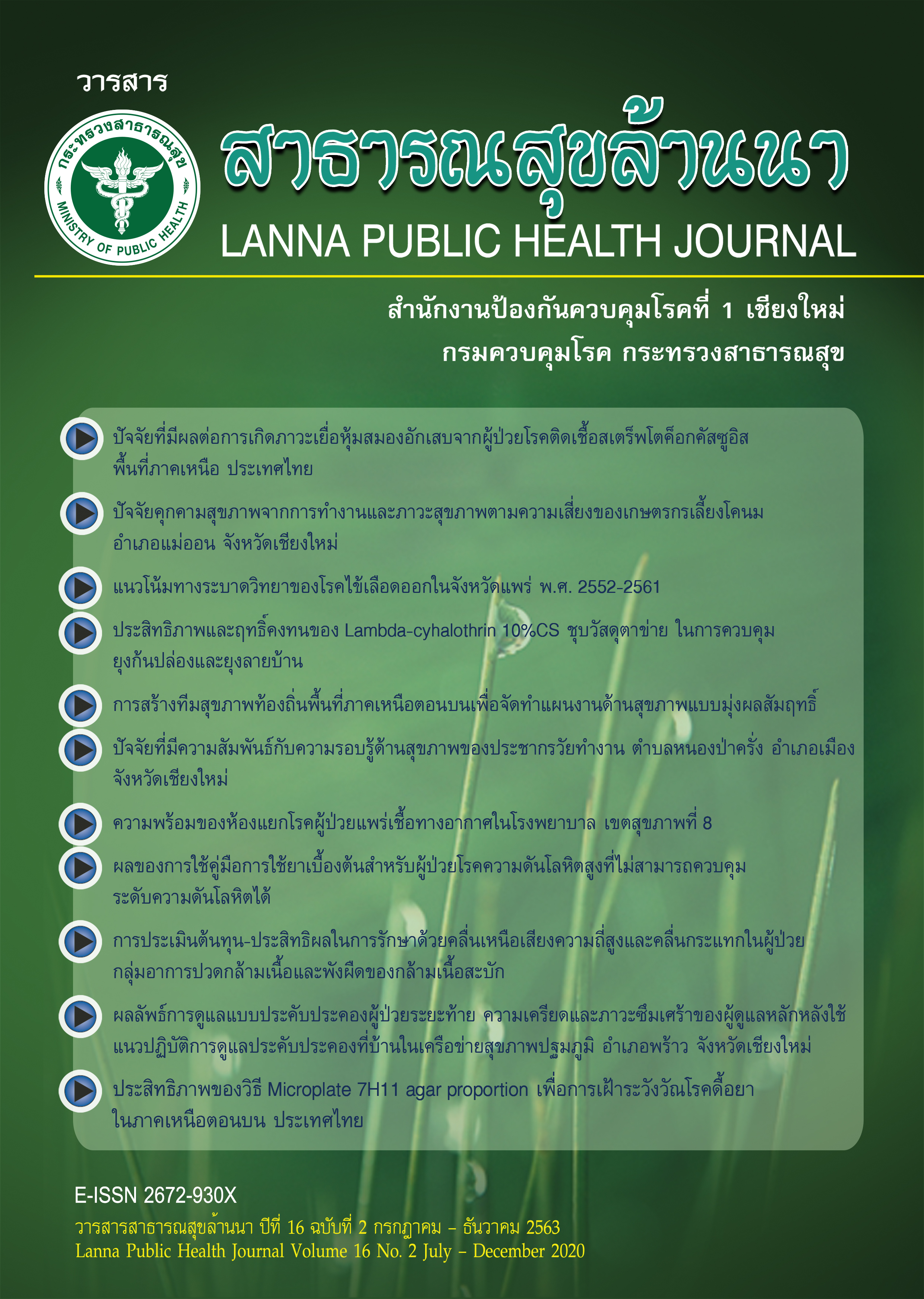Palliative Outcome Score, Stress and Depression of the Caregivers after Implemented Home-Based Palliative Care Guideline among Terminally Ill Patients of Primary Care Network, Phrao District, Chiang Mai Province
Keywords:
Terminally ill patients, Stress and depression of the caregivers, Home-based palliative care guidelineAbstract
This quasi - experimental research in one group aimed to determine palliative outcome, stress, and depression scores, of the caregivers after implementing the home-based palliative care guideline among terminally unwell patients in Phrao district’s primary care network during July - September 2017. The samples included 2 groups, firstly, 32 palliative patients who received palliative care at home, and, secondly, their caregivers. The sampled patients were purposively selected from the primary care network. The evaluation of outcomes performed before and after implementing the home-based palliative care guideline for Phrao district’s primary care network. Data collection method used Palliative Care Outcome Scale (POS) in a short version of a stress questionnaire (ST-5) and 2 questions of depression screening test of the Department of Mental Health. The paired t-test compared the means of palliative care outcome scores (POS) and stress test scores (ST-5). The data of risk were analyzed by descriptive statistics for characteristics and depression of the caregivers and presented in numbers, percentages, means, and standard deviations. The results revealed that after 32 patients received the implementation, the mean scores of POS significantly decreased from 14.22 (S.D.=7.31) to 9.69 (S.D.=6.78) and the mean score of caregivers’ stress significantly decreased from 4.13 (S.D.=3.48) to 2.84 (S.D.=3.49). Number of caregivers at risk of depression decreased from 34.40% to 12.50%. After the implementation, the patients improved palliative care outcome score and significantly reduced caregivers’ stress and risk of depression.
References
กรมการแพทย์. (2557). แนวทางการดูแลผู้ป่วยระยะสุดท้าย. กรุงเทพฯ: กระทรวงสาธารณสุข.
กรมสุขภาพจิต. (2555). คู่มือคลายเครียด (ฉบับปรับปรุงใหม่) [online]. [สืบค้นเมื่อ 22 เมษายน 2560]. แหล่งข้อมูล: https://www.dmh.go.th/ebook/result2.asp?id=345
กรมสุขภาพจิต. (2559). แบบคัดกรองโรคซึมเศร้า [online]. [สืบค้นเมื่อ 18 เมษายน 2560]. แหล่งข้อมูล: https://www.thaidepression.com/www/56/298Q.pdf
กรมสุขภาพจิต. (2559). แบบประเมินความเครียด (ST5) [online]. [สืบค้นเมื่อ 20 พฤษภาคม 2560]. แหล่งข้อมูล: https://www.dmh.go.th/test/qtest5/
กองยุทธศาสตร์และแผนงาน สำนักงานปลัดกระทรวงสาธารณสุข. (2559). สถิติสาธารณสุข พ.ศ. 2559 [online]. [สืบค้นเมื่อ 3 กันยายน 2563]. แหล่งข้อมูล: http://bps.moph.go.th/new_bps/sites/default/files/health_strategy2559.pdf
กองโรคไม่ติดต่อ กรมควบคุมโรค. (2559). ข้อมูลโรคไม่ติดต่อ จำนวนและอัตราผู้ป่วยใน ปี 2559-2561 [online]. [สืบค้นเมื่อ 3 กันยายน 2563]. แหล่งข้อมูล: http://www.thaincd.com/2016/mission/documents-detail.php?id=13684&tid=32&gid=1-020
คณะกรรมการพัฒนาระบบการดูแลผู้ป่วยที่บ้าน (Home ward) อำเภอพร้าว. (2560). รายงานสถิติจำนวนผู้ป่วย Home ward ปี พ.ศ. 2558-2560. เอกสารนำเสนอในที่ประชุมวางแผนการทำงานทีม Home ward อำเภอพร้าว, ห้องประชุมเอื้องพร้าว รพ.พร้าว จ.เชียงใหม่.
จุฬาวรี ชัยวงค์นาคพันธ์, ศิริกาญจน์ จินาวิน, วราภรณ์ ยศทวี, กชพร พงษ์แต้ และเจษฎาภรณ์ อิกําเหนิด. (2561). บทบาทของพยาบาลในการพัฒนาความสามารถและลดความเครียดของผู้ดูแลผู้ป่วยที่มีปัญหาในระบบประสาท. วารสารวิทยาลัยพยาบาลบรมราชชนนี อุตรดิตถ์, ฉบับพิเศษ (สิงหาคม – ตุลาคม), 151-162.
ช่อทิพย์ พรหมมารัตน์. (2560). ผลของการพัฒนารูปแบบการดูแลแบบประคับประคองที่บ้าน เครือข่ายสุขภาพอำเภอบ้านโฮ่ง จังหวัดลำพูน. วารสารสาธารณสุขล้านนา, 13(1), 25-36.
ดาริน จตุรภัทรพร. (2554). สุข รัก เข้าใจ ในช่วงสุดท้ายของชีวิต. กรุงเทพฯ: อมรินทร์พริ้นติ้งแอนด์พับลิชชิ่ง.
เพ็ญศิริ มรกต, กิตติกร นิลมานัต และเยาวรัตน์ มัชฌิม. (2558). ผลของโปรแกรมส่งเสริมการปรับตัวของญาติผู้ดูแลผู้ป่วยระยะสุดท้ายที่เจ็บป่วยด้วยโรคเรื้อรัง. วารสารสภาการพยาบาล, 30(2), 33-45.
ภัควีร์ นาคะวิโร. (2560). ผลลัพธ์การดูแลของผู้ป่วยมะเร็งแบบประคับประคองในโรงพยาบาลพระนครศรีอยุธยา. วารสารสมาคมเวชศาสตร์ป้องกันแห่งประเทศไทย, 7(1), 11-23.
ลดารัตน์ สาภินันท์. (2556). คู่มือการใช้แบบประเมินผลลัพธ์การดูแลผู้ป่วยแบบประคับประคองฉบับภาษาไทย (Palliative care Outcome Scale : POS). เชียงใหม่: บริษัท กลางเวียงการพิมพ์ จำกัด.
ลัญฉน์ศักดิ์ อรรฆยากร, พรเลิศ ฉัตรแก้ว, ภาวิกา ศรีรัตนบัลล์ และคณะ. (2560). นิยามและปัจจัยของการไม่สามารถจำหน่ายผู้ป่วยในออกจากโรงพยาบาล โดยการทำกลุ่มโฟกัส. จุฬาลงกรณ์เวชสาร, 61(4), 511-524.
ศูนย์การดูแลผู้ป่วยประคับประคอง โรงพยาบาลมหาราชนครเชียงใหม่. (2553). Suandok Palliative care Model [online]. [สืบค้นเมื่อ 28 พฤษภาคม 2560]. แหล่งข้อมูล: https://w2.med.cmu.ac.th/spc/index.php?option=com_content&view=article&id=21&Itemid=190&lang=en
สมพร อินทร์แก้ว, เยาวนาฏ ผลิตนนทเกียรติ, ศรีวิภา เนียมสอาด และสายศิริ ด่านวัฒนะ. (2552). พลังสุขภาพจิตเปลี่ยนร้ายกลายเป็นดี RQ: Resilience Quotient ศักยภาพทางอารมณ์และจิตใจที่จะช่วยพาคุณก้าวผ่านวิกฤติและความไม่แน่นอนของชีวิตได้อย่างสง่างาม. นนทบุรี: บริษัท ดีน่าดู จำกัด.
สำนักการพยาบาล สำนักงานปลัดกระทรวงสาธารณสุข. (2559). ระบบบริการพยาบาลแบบประคับประคอง. กรุงเทพฯ: บริษัท สำนักพิมพ์สื่อตะวัน จำกัด.
อรวรรณ ศิลปกิจ. (2551). แบบวัดความเครียดฉบับศรีธัญญา. วารสารสุขภาพจิตแห่งประเทศไทย, 16(3), 177-185.
Anderson, F., Downing, G. M., Hill, J., Casorso, L., & Lerch, N. (1996). Palliative performance scale (PPS): a new tool. Journal of palliative care, 12(1), 5-11.
Artsanthia, J., and Tillaput, J. (2019). The effect of palliative care to quality of life of people who living with end stage renal disease in community. Journal of The Royal Thai Army Nurses, 20(1), 226-235.
Brumley, R. D., Enguidanos, S., & Cherin, D. A. (2004). Effectiveness of a home-based palliative care program for end-of-life. Journal of palliative medicine, 6(5), 715-724.
Chewaskulyong, B., Sapinun, L., Downing, G. M., et al. (2012). Reliability and validity of the Thai translation (Thai PPS Adult Suandok) of the palliative performance scale (PPSv2). Palliative medicine, 26(8), 1034-1041.
Glajchen, M. (2016). Family caregivers in palliative care and hospice: minimizing burden and maximizing support. [cited 2020 Sep 3]; Available from: URL: https://www.nhpco.org/wp-content/uploads/2019/04/PalliativeCare_Family_Caregivers.pdf
Gomes, B., Calanzani, N., Curiale, V., McCrone, P., & Higginson, I. J. (2013). Effectiveness and cost-effectiveness of home palliative care services for adults with advanced illness and their caregivers. Cochrane Database of Systematic Reviews, (6).
Hudson, P., Trauer, T., Kelly, B. et al. (2013). Reducing the psychological distress of family caregivers of home-based palliative care patients: short-term effects from a randomised controlled trial. Psycho-oncology, 22(9), 1987-1993.
Labson, M. C., SACCO, C. M. M., Weissman, D. E., Gornet, B., & STUART, F. B. (2013). Innovative models of home-based palliative care. Cleveland clinic journal of medicine, 80(e-supplement 1).
Macmillan, K., Peden, J., Hopkinson , J., and Hycha, D. (2014). A caregiver’s guide. [cited 2020 Sep 3]; Available from: URL: https://www.stlazarus.ca/docs/publications/caregivers_guide_ 2015_en.pdf
Pairojkul, S. (2013). Home-based palliative care: making it happen. In Chanvet, L., The dawn of palliative care in Thailand. Bangkok: Beyond Enterprise.
Peters, L., & Sellick, K. (2006). Quality of life of cancer patients receiving inpatient and home-based palliative care. Journal of advanced nursing, 53(5), 524-533.
Stajduhar, K. I. (2013). Burdens of family caregiving at the end of life. Clinical and Investigative Medicine, 36(3), E121-E126.
World Health Organization. (2002). Definition of palliative care. [cited 2017 March 10]; Available from: URL: https://www.who.int/cancer/palliative/definition/en/
World Health Organization. (2018). Integrating palliative care and symptom relief into primary health care: a WHO guide for planners, implementers and managers. Geneva: WHO.








